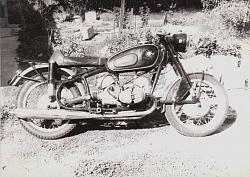

blkadder (Sep 12, 2020)
Does that combination make this derivative of leading link designs? DKW(?) and BMW had leading links long ago; I suppose the effectiveness mollified by unsprung weight. A bike is different, telescopic tubes small enough have to be fragile, and this looks pared down weight-wise to be practical, and easily maintained. It appears the bulk of this is sprung and barely more material than a plain wishbone fork. I imagine the rate is adjustable. No matter weight of demonstrator, a fast down hill could easily be just as much and quicker.

Sincerely,
Toolmaker51
...we'll learn more by wandering than searching...
It looks like a supersized version of the AMP Research fork from the 90s, which were a treat to rebuild - if you have OCD because the tolerances were so tight that you have to be very retentive to deal with the precision. I was the only one in the shop who actually liked working on them, so I got to do them all.
They were outdated by the time they hit the market due to their minuscule travel (which the fork above resolves), but they rode wonderfully and were very lightweight.
Neil
Bikes AMP Forks - the Buyer's Guide, 2015
blkadder (Aug 16, 2022), Toolmaker51 (Jul 22, 2020)
I think that a driving requirement with this design was to maintain near constant trail and wheelbase under suspension movement.
Whether that is a worthy goal or not is a separate question.
Toolmaker51 (Jul 22, 2020)
The idea of having constant trail is a mistaken one. There are many riding situations that cause suspension movement, if you design for constant trail in one situation then it will NOT be constant trial under other conditions, you may have created greater variation in some.
For example in the design of the unit under consideration here, it looks like trail is close to constant under the condition of pitching forward about the rear axle on level ground. This is close to the braking situation of a bike with no rear suspension, but the situation is completely different if the suspension is moved up due to a bump. Here is a part page from my chassis book, which briefly shows how the trail variation is dependent on the reason for the suspension compression (motochassis.com .
click for full size.
That shows how the concept of constant trail is not valid over all conditions but another consideration is " Is constant trail and/or constant wheelbase a worthy goal"?
The suspension compresses due to increased load on the front wheel, do you expect that the "ideal" trail is the same under different loading conditions. I think not.
olderdan (Jul 23, 2020), Toolmaker51 (Jul 24, 2020)
Alan,
There are many things that contribute to a good handling bike, so it is very risky to select one item from the whole mix and credit that.
The Earles' have many things in their favour but their main disadvantage is that they have high steered inertia, too much metal away from the steering axis. That slows the steering and I doubt that they are optimum for a trails bike. Another problem for a trails bike is that unless you have a very low pivot the axle path is fairly vertical. This is detrimental to pushing over bumps. The usual comment on this aspect is the "Is it easier to push or pull a wheelbarrel over a step?".
On the other hand the short links on the contemporary Greeves had much lower inertia and the shorter links allowed a rearward motion of the axle without having such a low pivot position to get hooked up on rocks etc..
I had 3 different BMWs with the Earles forks and in general they worked OK but there were two problems. The anti-dive was excessive because the brake back plate was fixed to the swing-arm. (I think that I see a parallel brake torque arm on the RHS in your photo, that is an indication that yours has a floating brake plate and the anti-dive will be about right.) As I mentioned the inertia was high which led to predicable wobbles as you slowed down through 40/30 mph. Back in my teens I made a set of short leading link forks to replace the Earles, the difference was chalk and cheese. No more wobbles, and nicer braking.
A youthful TF on the Earles' fork model.
Click for full size.
Now with my short link forks.

olderdan (Jul 24, 2020)
olderdan (Aug 17, 2022)
There are currently 1 users browsing this thread. (0 members and 1 guests)
Bookmarks